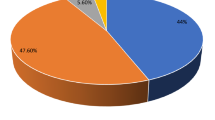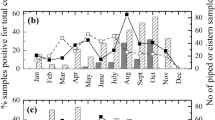Abstract
Background
Application of the point-of-use water treatment (POU-WT) systems has consistently increased during the last decade in Iran. In this study, the qualitative performances of reverse osmosis-based POU devices in selected cities of Iran were investigated.
Methods
This applied- descriptive study was conducted in three cities of Tehran, Rasht, and Ahvaz in 2016 (selected based on the level of POU devices sale index in three phases). After choosing the most popular five brands of six stages POU devices, 360 water sampling zones and POU consumer households of the selected cities were measured. Also, the awareness of the consumers about POU-WT systems selection and performance was investigated through a designed questionnaire.
Results
The qualitative parameters in the three cities were acceptable (p < 0.05) for tap water (except for EC in Ahvaz), the output water were as follows: pH = 6.05–7.5, EC = 49.8–58.2 μs/cm, TOC = 0.01–0.23 mg/L and Nitrate = 0.52–4.5 mg/LNO3 (lower or within the range of regulatory limits), Total Hardness = 33–41.5 mg/L and Fluoride = 0.01–0.23 mg/L (which were lower than the admissible limit, with p < 0.05), HPC values were in the range of 543–676 CFU/mL, which exceeded the regulatory level. Results of ANOVA analysis showed significant differences between the selected cities. The results of the questionnaire survey showed that the dissatisfaction of tap water quality and health-related concerns were the two main reasons for household POU-WT systems; awareness levels of 64% of these households about the performances of their POU systems were weak. Also, social media were mostly used by POU-WT users for brand selected.
Conclusion
Based on the results of the tap-water quality application of POU-WT systems are not recommended in Tehran and Rasht, and regarding the outputs of these systems, side effects of softened water, lack of Fluoride and a remarkable increase of the number of bacteria should be considered. In Ahvaz, application of POU-WT systems can decrease the health-related problems and it is necessary to increase the access to read POU-WT efficiency information for the consumers.






Similar content being viewed by others
References
Organization WH. Guidelines for drinking-water quality: World Health Organization; 2004.
Edition F. Guidelines for drinking-water quality. WHO chronicle. 2011;38:104–8.
Do AT, Kuroda K, Hayashi T, Nga TTV, Oguma K, Takizawa S. Household survey of installation and treatment efficiency of point-of-use water treatment systems in Hanoi, Vietnam. J Water Supply Res Technol AQUA. 2014;63(2):154–61.
Varol S, Davraz A. Evaluation of potential human health risk and investigation of drinking water quality in Isparta city center (Turkey). J Water Health. 2016;14(3):471–88.
Bolaji B, Bolaji G, Ismaila S. Performance evaluation of a locally developed domestic drinking water filter. Int J Environ Stud. 2010;67(5):763–71.
Dindarloo K, Ghaffari HR, Kheradpisheh Z, Alipour V, Ghanbarnejad A, Fakhri Y, et al. Drinking water quality: comparative study of tap water, drinking bottled water and point of use (PoU) treated water in Bandar-e-Abbas, Iran. Desalin Water Treat. 2016;57(10):4487–93.
Chaidez C, Gerba CP. Comparison of the microbiologic quality of point-of-use (POU)-treated water and tap water. Int J Environ Health Res. 2004;14(4):253–60.
Ebrahimi SM, Shiri Z, Mosavi SM, Memar MY. Bacteriological quality of water produced by household water treatment devices. Journal of Mazandaran University of Medical Sciences. 2015;25(130):8–18.
Peter-Varbanets M, Zurbrügg C, Swartz C, Pronk W. Decentralized systems for potable water and the potential of membrane technology. Water Res. 2009;43(2):245–65.
Sacchetti R, De Luca G, Dormi A, Guberti E, Zanetti F. Microbial quality of drinking water from microfiltered water dispensers. Int J Hyg Environ Health. 2014;217(2):255–9.
Zanetti F, De Luca G, Sacchetti R. Control of bacterial contamination in microfiltered water dispensers (MWDs) by disinfection. Int J Food Microbiol. 2009;128(3):446–52.
Fahiminia M, Mosaferi M, Taadi RA, Pourakbar M. Evaluation of point-of-use drinking water treatment systems’ performance and problems. Desalin Water Treat. 2014;52(10–12):1855–64.
Al-Haddad A, Al-Qallaf H, Rashid T. Effectiveness of domestic water filters. Desalin Water Treat. 2015;53(3):649–57.
Anumol T, Clarke BO, Merel S, Snyder SA. Point-of-use devices for attenuation of trace organic compounds in water. Journal: American Water Works Association. 2015;107(9).
Federation WE, Association A. Standard methods for the examination of water and wastewater. American public health association (APHA). Washington, DC: USA; 2005.
Safari Y, Asadi F, Amiri N, Motlagh ZJ, Azari A, Sharafi H, et al. Management of drinking water consumption at home: a case study of knowledge and attitude evaluation-Kermanshah, Iran (2015). Executive Editor. 2403;8(2):2017.
Iranian Institute of Standard and Industrial Researches (IISIR). Drinking water characteristics. In: Fifth ed.; 2010.
Organization INS. Desalinated drinking water in industrial and households systems-Micobial specifications. 2016.
Shehzadi R, Rafique H, Abbas I, Sohl MA, Ramay SM, Mahmood A, et al. Assessment of drinking water quality of tehsil Alipur, Pakistan. Desalin Water Treat. 2015;55(8):2253–64.
Fawell J. pH in drinking-water. Revised background document for development of WHO guidelines for drinking-water quality. Geneva: World Health Organization; 2007.
U.S. Environmental Protection Agency Secondary Drinking Water Standards: Guidance for Nuisance Chemicals [database on the Internet]. Available from: https://www.epa.gov/dwstandardsregulations/secondary-drinking-water-standards-guidance-nuisance-chemicals.
Yari A, Safdari M, Hadadian L, Babakhani M. The physical, chemical and microbial quality of treated water in Qom s desalination plants. 2007.
Khodadadi M, Mahvi A, Ghaneian M, Ehrampoush M, Dorri H, Rafati L. The role of desalination in removal of the chemical, physical and biological parameters of drinking water (a case study of Birjand City, Iran). Desalin Water Treat. 2016;57(53):25331–6.
van der Aa M. Classification of mineral water types and comparison with drinking water standards. Environ Geol. 2003;44(5):554–63.
Lucentini L, Pettine P, Stottmeister E, Menichini E. Chemical analysis of the quality of water for human consumption: proposal for the revision of the performance requirements in the drinking water directive 98/83/EC. TrAC Trends Anal Chem. 2013;45:37–47. https://doi.org/10.1016/j.trac.2012.12.014.
Selvam S, Manimaran G, Sivasubramanian P, Balasubramanian N, Seshunarayana T. GIS-based evaluation of water quality index of groundwater resources around Tuticorin coastal city, South India. Environmental earth sciences. 2014;71(6):2847–67.
Dzik A. Cerebrovascular disease mortality rates and water hardness in North Dakota. S D J Med. 1989;42(4):5–7.
Momeni M, Gharedaghi Z, Amin MM, Poursafa P, Mansourian M. Does water hardness have preventive effect on cardiovascular disease? Int J Prev Med. 2014;5(2):159–63.
Zoeteman BC. Sensory assessment of water quality: Pergamon series on environmental science: Elsevier; 2015.
Richard AM, Diaz JH, Kaye AD. Reexamining the risks of drinking-water nitrates on public health. Ochsner J. 2014;14(3):392–8.
Verma AK, Saksena D. A Review on various Point of Use-Drinking Water Purification Technologies.
Jeri BA. The fluoride concentration of bottled drinking water in Al-Basra City, Iraq. Journal of Baghdad College of Dentistry. 2016;28(1):143–6.
Somasundaram S, Ravi K, Rajapandian K, Gurunathan D. Fluoride content of bottled drinking water in Chennai, Tamilnadu. J Clin Diagn Res. 2015;9(10):ZC32–4.
Miranzadeh MB, Rabbani DK. Chemical quality evaluation for the inlet and outlet water taken from of the desalination plants utilized in Kashan during 2008. KAUMS Journal (FEYZ). 2010;14(2):120–5.
Florentin A, Hautemanière A, Hartemann P. Health effects of disinfection by-products in chlorinated swimming pools. Int J Hyg Environ Health. 2011;214(6):461–9.
Pindi PK, Yadav PR, Kodaparthi A. Bacteriological and physico-chemical quality of main drinking water sources. Pol J Environ Stud. 2013;22:825–30.
Diduch M, Polkowska Ż, Namieśnik J. The role of heterotrophic plate count bacteria in bottled water quality assessment. Food Control. 2016;61:188–95.
Iranian National Standardization Organization, Desalinated drinking water in industrial and households systems-Micobial specifications, 2016.
Acknowledgments
The present article has been financially supported by Center for Water Quality Research, Institute for Environmental Research, Tehran University of Medical Sciences, with Research code No. of 29230. The authors would like to sincerely thank Iran University of Medical Sciences and Ahvaz Jundishapur University of Medical Sciences for their cooperation.
Author information
Authors and Affiliations
Corresponding authors
Ethics declarations
Conflict of interest
The authors declare that there are no conflicts of interests.
Rights and permissions
About this article
Cite this article
Rezaeinia, S., Nasseri, S., Binesh, M. et al. Qualitative and health-related evaluation of point-of-use water treatment equipment performance in three cities of Iran. J Environ Health Sci Engineer 16, 265–275 (2018). https://doi.org/10.1007/s40201-018-0315-5
Received:
Accepted:
Published:
Issue Date:
DOI: https://doi.org/10.1007/s40201-018-0315-5




